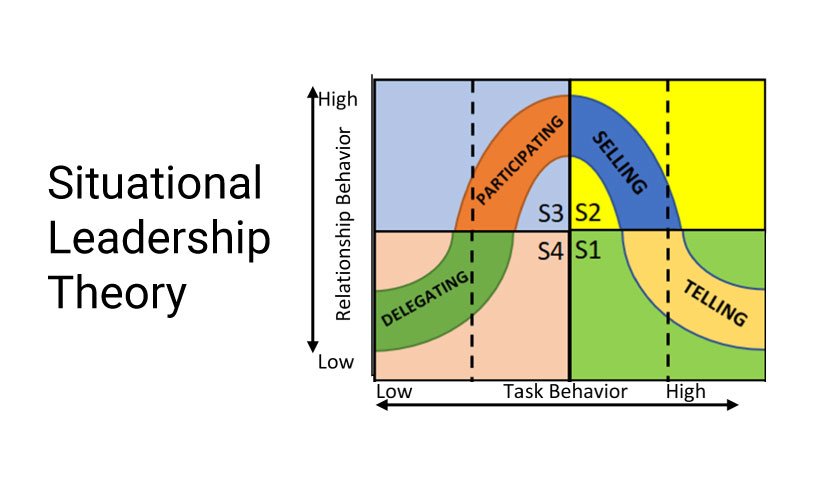If you were in charge of a new project, what would you do to apply situational leadership theory appropriately? Well, before going to answer that particular question, we must elaborate on this theory firstly. In the field of leadership, situational leadership theory has been gaining attention in recent years. This leadership involves the ability to adapt and use appropriate strategies based on the situation at hand. After that, success knocks on the door eventually.
For digging this file of this leadership, we have initiated this article. Here, we will discuss and present every potential aspect of this theory. After that, you can analyze and apply this theory successfully in your organization. Is there anything more that you can expect here? Of course, we will let you gather the real-time experience through words. So, without wasting time, let's jump to the next phases.
Situational Leadership Theory Definition
Most importantly, this theory is a concept that states that leaders can lead in different ways depending on the situation. It also explains why certain leaders are effective in particular circumstances. In fact, this theory proposes that there are three situations that are commonly encountered in leaders’ work. The situations are where people interact (a team), with whom they interact (their network), and the situation itself (the environment).
Here, a leader's goal is to solve problems, increase engagement, and make a difference. You know what; famous psychologist Albert Bandura first described this theory. In doing so, he developed his notion of social cognitive theory. But, it was first studied by American political scientist Robert House.
In this way, this theory got a full formation to be applicable in the real field.
You know what; this theory explains why certain leaders are effective in particular conditions. In the context of organizational culture, it refers to leaders' particular abilities. Actually, the ability is to consider their employees' personal styles to adapt their actions in response to their employees' needs. Based on this logic, you may hold it as a subset of transformational leadership as well.
Application of Situational Leadership Theory
In recent years, situational leadership theory has emerged as an important management tool. However, it refers to the ability of leaders to set the context in which they operate. It can be used to generate rich insights into the nature of leadership at different levels and in different arenas. In this style, leaders need to be flexible in order to lead the organization through change. They must be smart and quick to leaders adapt their strategies based on the conditions.
For instance, those situations can be a crisis, transition, or conflict. People have been using situational leadership theory to provide an explanation for how leaders could be good and bad. This theory is a good way to explain why certain managers behave the way they do. But, it does not allow us to judge their effectiveness or understand their performance.
You know what; it is a great tool for both leaders and followers. The main idea of situational leadership theory is that situations are the source of all leadership. Besides, the idea includes the ability to lead in different states depending on a leader's skills, beliefs, knowledge, and personality. The most effective leaders can enrich the functionality of the workers through changeable actions and strategies.
Moreover, this theory is highly applicable to inspire people, solve problems, and build a successful company. However, building a successful company is more than just having leaders who are good at their jobs. In reality, this leadership style plays an important role in the way a company functions. Here, leaders act based on their experiences using their sense and judgment. It is an aspect of human behavior that leaders must understand to gain influence over employees.
Situational Leadership Theory: Hersey and Blanchard Model
We all know that being an effective leader is important to the success of any organization. However, it is not as easy as it seems. In fact, there are several different leadership styles to choose from. The Hersey and Blanchard model of situational leadership theory is one of the most popular models in this field. Within this leadership, Blanchard and Hersey's model adds four apt styles. Actually, these styles are the core part of this model. Let's grab an elaborated discussion for better insights.

• Telling or Directing:
Firstly, Hersey and Blanchard Model describe this style. You may call it an autocratic style as well. Here, leaders have the final say on major decisions. As you have probably noticed, there are two types of decision-making styles: consensus and dictatorship. While consensus is widely used in organizations today, dictatorships are becoming more popular.
In fact, the majority of organizations use some form of one or the other style today. This style is more applicable for crisis moments where speedy and immediate action is exigent. Here, the leaders dictate the subordinates to do the tasks on demand and accordingly.
• Coaching:
Adopting a more coaching role allows leaders to influence the actions of their team members while avoiding micromanagement. Besides, the leaders make sure that they are working towards the same goals. For the past few years, the skills of an effective leader have gathered value more highly than ever.
It has led to a phenomenon called “The Era of Management ."Here, managers are hired not only for their competence but also for communicating with their team and delivering results. This style of management puts the leader in more of a coaching role rather than a directing one.
• Participating and Sharing:
This style suggests that the subordinates have strong participation in determining the outcome and making the decisions. This can be shown through the manner in which they communicate and listen to their supervisor. The senior leader must be proactive, making sure that all stakeholders are aware of what is happening with the project.
You know what; Blanchard and Hersey analyzed a wide range of data to set this model. It shows that employees with more decision-making power feel more satisfied, enjoy their work more, are healthier, make better decisions, and generally do a better job.
• Delegating:
In many organizations, leaders give the authority to a group or team of people to make decisions and approve work. This delegation can be effective when done well. But, it is also important to ensure that decision-making is effectively distributed across multiple individuals.
In order to avoid burning out, it is important that you allow your team members room to experiment with new and creative ways of working. It is workable only when you are part of a team, especially in high-pressure situations. If you want to be an effective leader, it is important that you know how to delegate authority and responsibility.
Situational Leadership Theory: Strengths and Weaknesses
In this phase, we will explore the strength and weaknesses of situational leadership theory. Here, we already know that examines the leader's ability to adapt to their environment and what factors influence their actions. In addition, it is a study in applied psychology that looks at how leaders interact with other people and situations.
On the other hand, the situational leadership theory has shown to be effective in promoting high performance. However, there are still debates on the impact of situational leadership in diverse contexts and industries. That is why; let’s jump to the next lines to find out its strength and weakness.
Strength:
• Flexible:
It is a technique that allows leaders to flexibly adjust their style based on the situation. Besides, it emphasizes adaptive thinking and action and is more flexible than conventional leadership models. It focuses on understanding your team and the situations they face. In fact, this concept enables leaders to adapt their approach and strategy to the changing environment.
You know what; this leadership style is a very broad and wide concept. It can mean different things to different people. In this style, the sets strategies and actions place which are flexible. Thus, everything may turn into an alternative formation based on the demand of the situation.
• Straightforward and Intuitive:
Most importantly, it does not require complex concepts or systems to be applied. But, it comes based on a simple definition. Here, it utilizes each situation’s unique characteristics to create the best possible outcomes. For example, if you are leading a team at work and want to gain consensus on a project or issue, then you should probably use a meeting-based approach.
Here, the leaders achieve organizational goals through natural means rather than conscious planning. The intuitive skill is a crucial part of this leadership. Most importantly, leaders can take a situation and see it from multiple perspectives. It is about identifying the relevant factors and thinking in the present tense, not just the past or future.
• Creativity Booster:
This leadership style is the art of bringing out the best in people without dictating how they should do things. Truly, it is an approach to leadership that puts individuals first while also encouraging them to think out of the box. In this form of leadership, leaders focus on the specific situation and how to leverage it to impact.
They think like change agents who lead their teams to find innovative solutions for everyday challenges. You know what; it is about leaders who can adapt to situations and those that have a creative mindset.
Weakness:
• Short-Term Goal:
Leaders and managers must be able to handle their employees' day-to-day needs. And they must also understand the long-term goals of the organization. However, those two aspects are not always linked to each other because leaders tend to focus on immediate needs rather than long-term needs.
But, it is not enough for companies that have to work towards something bigger. A business needs to use a balanced approach where it can analyze the current situation and eye on the long-term goal. Besides, they must make a plan to find out a solution. Here, this leadership can cause problems if it does not address long-term needs.
• Ineffective for Task-Oriented Environment:
According to management theories, the most effective leadership styles are task-oriented. In these situations, leaders guide their employees on how to do their jobs. Besides, they provide feedback on what they have done. However, a recent study found that situational leadership can be less effective in task-orientated environments.
It is because; some leaders do not contain the ability to understand the impact of their actions. Besides, they cannot determine the outcome as well. It happens mostly when the situation is quite stressful. In this case, the organization may face challenges and fail to achieve goals.
• Poor Supervision:
In this leadership style, leaders delegate the authority to the employees. Besides, they trust them with core responsibilities as well. Truly, it is easy to over-trust your employees, especially when they have the potential to be better than you. But, it also may lead you to failure.
You know what; poor supervision is a big weakness of situational leadership. Here, leaders rely on their team members' ability to make decisions. Although this may seem like a good thing, it can also lead to lower productivity and risk-taking.
Situational Leadership Theory Examples
Situational leadership theory is a set of principles for the development of leaders based on their situation and objectives. Most importantly, it involves situational awareness and understanding, relationships with others, power influence, and action orientation. In this phase, we will provide some examples of situations where situational leadership theory is relevant.
The coaches of the sports team are using situational leadership theory. You know what; this theory states that a leader is most effective when he or she adapts to their situation. Therefore, the coach should understand the players' strengths and weaknesses and adapt to this information. This approach can provide a way for coaches to positively influence their players. After that, the players continue to improve themselves and their performance.
On the other hand, emergency situations are highly unpredictable. At times, they are like a giant black box where we do not know what is going to happen. Most importantly, it requires the on-field people to make decisions quickly according to the current situation. They have to do it without waiting for orders from a superior officer. In these cases, this leadership style is more applicable. For instance, we can name more such as the military and healthcare.
Conclusion
Hopefully, you have explored every aspect of situational leadership theory in the above lines. Well, the tour will end here with a short note. As a leader, you may often tend to lead people in a specific way. But, it cannot always be fruitful. Sometimes, the situation appears differently and seeks a different plan of action. In this case, situational leadership can be the best solution. This leadership style is a process where leaders adapt to conditions and set the strategy according








